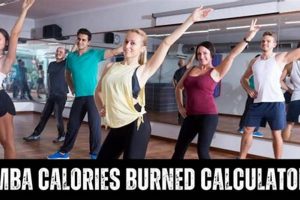The quantity of energy expended during a Zumba class varies based on individual factors such as weight, fitness level, and the intensity of the workout. Estimates suggest that a typical Zumba session can result in an energy expenditure ranging from 300 to 900 calories. This variability makes precise calculation challenging without personalized data.
Understanding the approximate caloric expenditure during Zumba is beneficial for individuals aiming to manage their weight, improve cardiovascular health, or maintain overall fitness. The dance-fitness program’s combination of aerobic exercise and interval training contributes to its effectiveness in promoting calorie consumption and enhancing metabolism. Furthermore, participation in Zumba fosters a positive and engaging exercise environment, potentially increasing adherence and long-term health benefits.
Subsequent sections will delve into the specific factors influencing energy expenditure during a Zumba class, explore methods for estimating individual caloric burn, and discuss strategies for maximizing the fitness benefits derived from this popular activity. This will provide a more detailed understanding of the metabolic impact of Zumba and its role in a comprehensive fitness regimen.
Maximizing Calorie Expenditure During Zumba
To optimize the metabolic benefits derived from Zumba, consider the following strategies, each designed to enhance energy consumption and overall fitness gains.
Tip 1: Maintain Consistent Intensity: Sustaining a high level of exertion throughout the Zumba session is crucial. Focus on actively engaging major muscle groups and minimizing rest periods to elevate the heart rate and maximize calorie burn.
Tip 2: Incorporate Full Range of Motion: Executing each dance move with a complete range of motion increases muscle activation and energy expenditure. Pay attention to proper form to ensure effective muscle engagement and prevent potential injuries.
Tip 3: Wear a Heart Rate Monitor: Utilizing a heart rate monitor provides real-time feedback on the intensity of the workout. Aim to maintain a target heart rate zone that promotes optimal fat burning and cardiovascular conditioning.
Tip 4: Add Resistance Training Elements: Integrating light weights or resistance bands into certain Zumba routines can further enhance muscle activation and calorie expenditure. This approach also contributes to improved muscle strength and endurance.
Tip 5: Focus on Proper Posture: Maintaining correct posture throughout the Zumba session engages core muscles and supports proper body alignment. This not only enhances the effectiveness of the workout but also reduces the risk of strain or injury.
Tip 6: Increase Class Frequency: Participating in Zumba classes multiple times per week can lead to significant cumulative calorie expenditure and improved fitness levels. Consistency is key to achieving long-term health benefits.
Tip 7: Combine with a Balanced Diet: Complementing Zumba workouts with a nutritious and balanced diet is essential for optimizing weight management and overall well-being. Focus on consuming whole, unprocessed foods and maintaining a caloric deficit if weight loss is the goal.
Adhering to these strategies can significantly enhance the caloric expenditure and overall fitness benefits associated with Zumba. Integrating these tips into a regular Zumba routine can contribute to improved cardiovascular health, weight management, and enhanced physical well-being.
The subsequent section will explore common misconceptions surrounding calorie expenditure during exercise and provide evidence-based guidance for achieving realistic fitness goals.
1. Individual's Weight
Body weight serves as a primary determinant of the number of calories expended during physical activity, including Zumba. Individuals with higher body weights generally expend more energy to perform the same movements as those with lower body weights. This relationship stems from the increased metabolic demand required to move a larger mass against gravity and maintain postural stability during exercise.
For example, an individual weighing 200 pounds will typically burn more calories in a Zumba class than an individual weighing 150 pounds, assuming all other factors, such as intensity and duration, remain constant. This difference arises because the heavier individual’s body must work harder to execute the dance steps and sustain the physical demands of the workout. Consequently, weight-bearing activities like Zumba place a greater energetic burden on individuals with higher body masses.
Understanding the role of body weight in calorie expenditure has practical significance for fitness planning and weight management. Recognizing that caloric burn is influenced by individual mass allows for more realistic goal setting and tailored exercise prescriptions. While weight loss contributes to a reduced caloric expenditure during subsequent Zumba sessions, the initial higher burn underscores the potential benefits of the activity for weight management in individuals across a spectrum of body weights. Therefore, body weight is a central component when estimating the number of calories burned from Zumba.
2. Fitness Level
An individual’s fitness level significantly impacts the number of calories expended during Zumba. A higher level of fitness typically correlates with a more efficient cardiovascular system and muscular endurance. Consequently, a fitter individual may perform the same Zumba routine with less effort than someone with a lower fitness level. This increased efficiency translates to a potentially lower caloric expenditure for the fitter individual, as the body is more adept at utilizing energy and performing the required movements.
Consider two individuals of similar weight participating in the same Zumba class. The first individual, a seasoned athlete with a high degree of cardiovascular fitness, may experience a moderate increase in heart rate and minimal muscle fatigue. The second individual, new to exercise and with a lower fitness level, will likely experience a significantly higher heart rate and greater muscle fatigue. Although both individuals are engaging in the same activity, the fitter individual’s body is more efficient at utilizing energy, resulting in a lower calorie burn for the same duration and intensity of exercise. Over time, improvements in fitness can lead to a progressive decrease in the number of calories burned during a given Zumba session, necessitating adjustments to workout intensity or duration to maintain a desired caloric expenditure.
Understanding the influence of fitness level on caloric expenditure during Zumba underscores the importance of progressive overload in exercise programming. As fitness improves, the body adapts, and the same routine becomes less challenging. Therefore, to continue maximizing caloric burn and achieving fitness goals, it is essential to progressively increase the intensity, duration, or complexity of Zumba workouts. Monitoring heart rate and perceived exertion can assist in gauging the appropriate level of challenge and ensuring that the body is sufficiently stimulated to expend a desired number of calories. Recognizing the impact of fitness level ensures that caloric expenditure is related to workout difficulty.
3. Class Intensity
The exertion level demanded by a Zumba class directly influences energy expenditure during participation. High-intensity classes, characterized by rapid movements, complex choreography, and minimal rest periods, correlate with a significant increase in caloric burn. Conversely, low-intensity sessions, featuring slower rhythms, simpler steps, and extended recovery times, result in a comparatively lower energy expenditure. The degree of physical demand imposed on participants determines the extent of metabolic activity stimulated and, consequently, the magnitude of the caloric deficit achieved.
Consider two distinct Zumba scenarios. A high-intensity Zumba class incorporating interval training, plyometric exercises, and dynamic movements elicits a heightened cardiovascular response and increased muscle activation. The body requires more energy to fuel these processes, leading to a substantial increase in calorie consumption. On the other hand, a low-impact Zumba class focused on gentle movements and balance exercises demands less energy. While both classes offer health benefits, the high-intensity session promotes a significantly greater caloric deficit, contributing more effectively to weight management or overall fitness goals. Therefore, participants targeting a specific caloric expenditure should select classes with an intensity level aligned with their fitness capabilities and objectives.
In summary, the intensity of a Zumba class is a critical determinant of caloric expenditure. Individuals seeking to maximize calorie burn should prioritize high-intensity sessions that challenge their cardiovascular and muscular systems. Recognizing this relationship enables informed decision-making, allowing participants to tailor their Zumba experience to their specific fitness needs and desired outcomes. However, one need to consider other factors and make sure that you don’t over-work yourself.
4. Metabolic Rate
Metabolic rate, the rate at which the body expends energy at rest and during activity, plays a crucial role in determining the total number of calories burned during a Zumba session. Individual variations in metabolic rate influence the baseline energy requirements of the body and subsequently affect the magnitude of caloric expenditure resulting from exercise.
- Basal Metabolic Rate (BMR)
BMR represents the energy required to maintain essential bodily functions at rest, such as breathing, circulation, and cellular activity. A higher BMR signifies that the body burns more calories even without physical exertion. Individuals with elevated BMRs will typically expend more calories during Zumba compared to those with lower BMRs, assuming all other factors remain constant. For instance, an individual with a higher muscle mass generally has a greater BMR, resulting in increased energy consumption during Zumba. The BMR serves as the foundation upon which the additional energy demands of physical activity are added.
- Thermic Effect of Food (TEF)
TEF refers to the energy expended by the body to digest, absorb, and process nutrients from food. Consuming meals with a higher protein content generally elicits a greater thermic effect compared to meals primarily composed of carbohydrates or fats. While the direct impact of TEF on caloric expenditure during a single Zumba session may be limited, dietary choices can influence overall metabolic activity and potentially affect energy utilization during exercise. A diet rich in protein, combined with Zumba, can contribute to a greater cumulative caloric burn over time.
- Activity Thermogenesis (AT)
AT encompasses the energy expended during physical activity, including exercise like Zumba, as well as non-exercise activity thermogenesis (NEAT), which includes activities such as walking, standing, and fidgeting. The proportion of AT derived from Zumba depends on the duration, intensity, and frequency of participation. Individuals who engage in regular Zumba sessions will experience a significant increase in AT, contributing to a higher overall caloric expenditure and improved metabolic health. Furthermore, the cumulative effect of increased AT from Zumba can potentially elevate BMR over time, leading to a sustained increase in daily caloric burn.
- Non-Exercise Activity Thermogenesis (NEAT)
NEAT represents the energy expended for all physical activities other than planned exercise, including fidgeting, standing, and walking. Individuals with higher NEAT levels tend to burn more calories throughout the day, even when not actively exercising. While NEAT may not directly influence caloric expenditure during a specific Zumba session, it contributes to the overall metabolic rate and daily energy balance. Incorporating strategies to increase NEAT, such as taking the stairs instead of the elevator or standing while working, can complement Zumba workouts and further enhance caloric expenditure.
In conclusion, metabolic rate, encompassing BMR, TEF, AT, and NEAT, interacts with the demands of a Zumba workout to determine total energy expenditure. Understanding these facets of metabolic rate enables a more comprehensive assessment of how Zumba contributes to overall fitness and weight management. An individual’s unique metabolic profile significantly influences the impact of Zumba on caloric burn, necessitating personalized approaches to exercise and nutrition.
5. Duration
The length of a Zumba class directly impacts the cumulative number of calories expended. A longer duration provides an extended opportunity for sustained physical activity, leading to a greater overall caloric burn. This relationship is predicated on the principle that continuous exercise, even at a moderate intensity, results in a higher total energy expenditure compared to shorter bursts of activity. For example, a 60-minute Zumba class will typically result in a greater caloric deficit than a 30-minute session, assuming similar intensity levels and individual characteristics. The extended timeframe allows for continued cardiovascular exertion and muscular engagement, which are essential for promoting energy consumption.
The practical significance of understanding the connection between class duration and caloric expenditure lies in its implications for fitness planning and goal setting. Individuals aiming to achieve a specific caloric burn can adjust the duration of their Zumba workouts accordingly. Furthermore, awareness of this relationship can inform decisions regarding class selection. For instance, if an individual has limited time, a higher-intensity Zumba class of shorter duration may be preferable to a longer, lower-intensity session. Conversely, those with more time available may opt for a longer class at a moderate intensity. By considering the interaction between duration and intensity, individuals can tailor their Zumba participation to effectively meet their specific fitness needs.
In summary, the duration of a Zumba class is a critical factor influencing the cumulative number of calories burned. A longer class duration provides an extended opportunity for sustained physical activity, leading to a greater overall caloric expenditure. Recognizing this relationship enables individuals to make informed decisions regarding class selection and workout planning, ensuring that their Zumba participation aligns with their fitness objectives. Therefore, individuals can actively adjust class duration to align with individual needs.
6. Muscle Mass
Muscle mass significantly influences the amount of energy expended during Zumba. Muscle tissue is metabolically active, requiring more energy to maintain compared to fat tissue. Individuals with a higher proportion of muscle mass exhibit an elevated basal metabolic rate (BMR), leading to a greater number of calories burned, even at rest. During Zumba, the increased muscle activation resulting from a higher muscle mass contributes to a greater overall energy expenditure. For example, two individuals of the same weight participating in the same Zumba class may exhibit different caloric burns based on their respective muscle mass percentages. The individual with greater muscle mass will likely expend more energy due to the increased metabolic demands of the exercise. This relationship underscores the importance of muscle mass as a key component in determining caloric expenditure during physical activity, including Zumba.
Furthermore, the long-term benefits of increased muscle mass extend beyond individual Zumba sessions. Regular participation in Zumba, coupled with resistance training, can promote muscle hypertrophy, further increasing BMR and contributing to sustained weight management. The cumulative effect of increased muscle mass and regular Zumba workouts can significantly enhance metabolic health and overall fitness. Individuals seeking to maximize the caloric expenditure during Zumba may benefit from incorporating strength training exercises into their fitness regimen to promote muscle growth and enhance metabolic activity. This integrated approach optimizes the physiological benefits of both cardiovascular and resistance training, resulting in a more efficient and sustainable approach to weight management and overall well-being.
In summary, muscle mass plays a crucial role in determining the amount of energy expended during Zumba. A higher proportion of muscle tissue elevates BMR and increases muscle activation during exercise, leading to a greater caloric burn. Recognizing this connection is essential for understanding the metabolic benefits of Zumba and for developing effective strategies for weight management and fitness improvement. Increasing muscle mass through resistance training can augment the benefits of Zumba, promoting long-term metabolic health and enhancing overall well-being. Therefore, individuals can enhance their health by coupling zumba with resistance training.
Frequently Asked Questions
This section addresses common inquiries regarding energy expenditure during Zumba, offering concise and informative responses to prevalent concerns.
Question 1: Does body weight influence the number of calories expended during Zumba?
Yes, body weight is a significant factor. Individuals with higher body weights generally expend more energy during physical activity, including Zumba, due to the increased metabolic demand required to move a larger mass.
Question 2: How does individual fitness level affect caloric expenditure during Zumba?
Higher fitness levels typically correlate with increased efficiency. Fitter individuals may expend fewer calories performing the same Zumba routine compared to less fit individuals due to enhanced cardiovascular and muscular efficiency.
Question 3: What role does class intensity play in determining caloric burn during Zumba?
Class intensity is a primary determinant. High-intensity Zumba classes, characterized by rapid movements and minimal rest, lead to a greater caloric burn compared to low-intensity sessions.
Question 4: Is metabolic rate a factor in the number of calories expended during Zumba?
Yes, metabolic rate, encompassing basal metabolic rate (BMR), thermic effect of food (TEF), and activity thermogenesis (AT), influences caloric expenditure. Individuals with higher metabolic rates generally burn more calories, even at rest.
Question 5: How does the duration of a Zumba class impact caloric expenditure?
Class duration directly influences cumulative caloric expenditure. Longer Zumba classes provide an extended opportunity for sustained physical activity, leading to a greater overall caloric burn.
Question 6: Does muscle mass affect the number of calories expended during Zumba?
Yes, muscle mass is a contributing factor. Muscle tissue is metabolically active, and individuals with higher muscle mass exhibit an elevated BMR, resulting in a greater number of calories burned during Zumba.
In conclusion, several factors interact to determine energy expenditure during Zumba, including body weight, fitness level, class intensity, metabolic rate, duration, and muscle mass. Considering these aspects enables a more comprehensive understanding of the metabolic impact of Zumba.
Subsequent sections will delve into practical strategies for incorporating Zumba into a comprehensive fitness plan and maximizing its benefits for weight management and overall well-being.
Understanding Caloric Expenditure in Zumba
The analysis of how many calories do you burn from zumba reveals a complex interplay of factors. Individual body weight, fitness level, class intensity, metabolic rate, duration, and muscle mass all exert a significant influence on the resulting energy expenditure. These factors, while individually impactful, interact synergistically to determine the overall caloric burn during a Zumba session. Therefore, precise estimation requires careful consideration of these variables and their combined effects.
The information presented underscores the importance of personalized approaches to fitness planning. While general guidelines exist, individual responses to Zumba can vary considerably. Individuals are encouraged to utilize this knowledge to tailor their Zumba participation, optimize their fitness outcomes, and achieve their health goals through informed and strategic engagement. Furthermore, continued research and technological advancements promise to refine methods for accurately assessing caloric expenditure, thereby enabling even more precise and effective fitness strategies.







